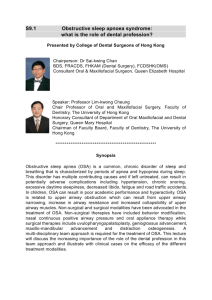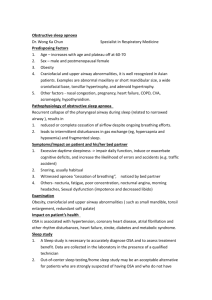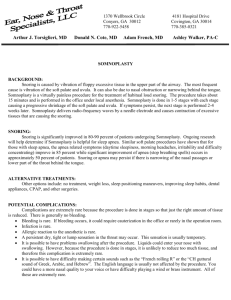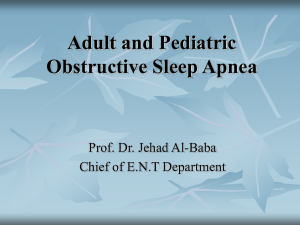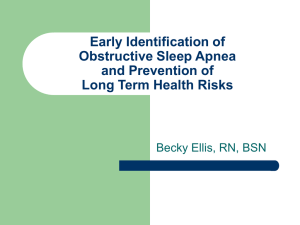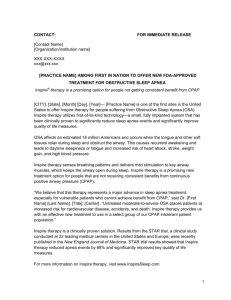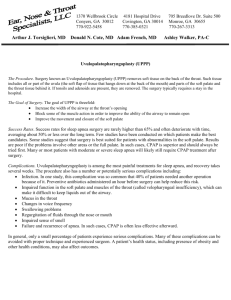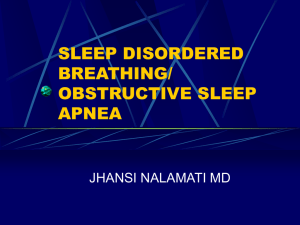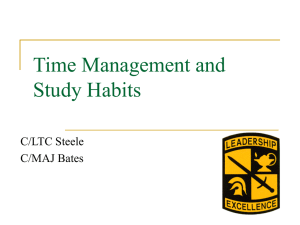Sleep Apnea
advertisement
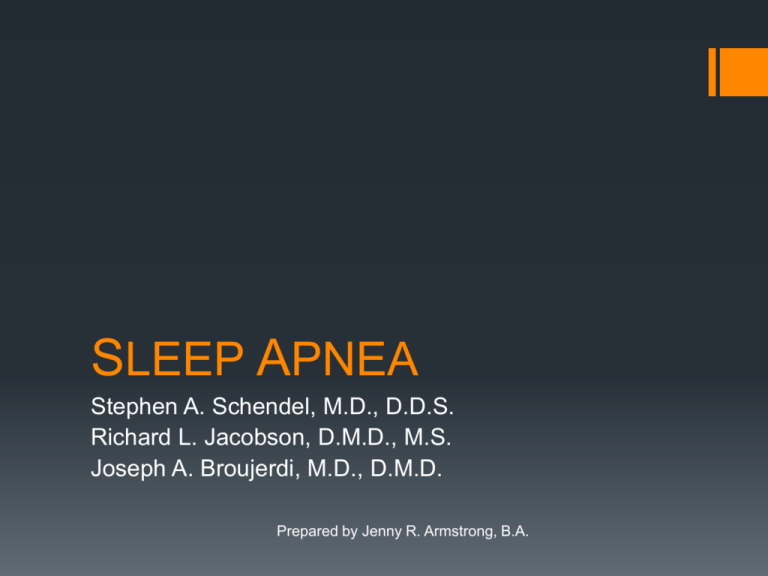
SLEEP APNEA Stephen A. Schendel, M.D., D.D.S. Richard L. Jacobson, D.M.D., M.S. Joseph A. Broujerdi, M.D., D.M.D. Prepared by Jenny R. Armstrong, B.A. STEPHEN A. SCHENDEL, M.D., D.D.S. Surgical interests are craniofacial and maxillofacial surgery, including sleep apnea and orthognathic surgery Professor of Surgery Emeritus at Stanford University Medical Center and Lucile Packard Children’s Hospital EDUCATION AND TRAINING: Graduate of University of Minnesota Dental School in 1973 Residency at Parkland Memorial Hospital in Dallas Studied as a Fulbright Fellow at the University of Nantes in France Emphasis of cleft lip & palate surgery and dentofacial orthopedics under the tutelage of Dr. Jean Delaire Graduate of University of Hawaii Medical School in 1983 Assistant to Dr. Paul Tessier 1987 to 1988 in Paris, France General Surgery internship at Baylor University Medical Center, Dallas General Surgery and Plastic Surgery training at Stanford University Medical Center ACHIEVEMENTS: Recipient of a Chateaubriand French Research Fellowship Full-time faculty of the Division of Plastic and Reconstructive Surgery at Stanford University Medical School from 1989 until 2007 Leader in the field of distraction osteogenesis for the correction of facial deformities. Board-certified in Oral and Maxillofacial Surgery and Plastic Surgery Fellow of the American College of Surgeons Fellow in the American Academy of Pediatrics Former President of the American Society of Maxillofacial Surgeons Former board member of the American Society of Plastic Surgeons from 1992 to 2002 Former Chief of Plastic Surgery at Stanford University Medical Center and Chief of Pediatric Surgery Chairman of the Department of Functional Restoration from 1994 to 2001 Director of The Craniofacial Anomalies Center at Lucile Packard Children’s Hospital from 1994-2007 Full-time faculty of the Division of Plastic and Reconstructive Surgery at Stanford University Medical School from 1989 until 2007 PUBLICATIONS He has published over 100 articles and chapters including a textbook on maxillofacial surgery. RICHARD L. JACOBSON, D.M.D., M.S. Board certified orthodontist practicing in Pacific Palisades for 30 years Additional areas of interest and expertise include orthognathic surgery and temporomandibular joint disorders Part-time instructor at UCLA School of Dentistry Department of Orthodontics EDUCATION AND TRAINING: UCLA School of Dentistry Department of Orthodontics 1981 M.S. in Oral Biology UCLA 1979-1983 TMJ Department American Institute of Bioprogressive Education Mentored by Robert M. Ricketts, D.D.S., M.S., and Tom Graber, D.D.S., M.S, PhD. SERVICE Director of the Foundation for Orthodontic Research and Education 1990-2000, elected President in 2000 Director of the Western Orthogmorphic Diagnostic team Service on the UCLA/St. John's Cleft Palate and Craniofacial Team President of the UCLA Orthodontics Alumni Association 1985, 2001 Reviewer for the American Journal of Orthodontics and World Journal of Orthodontics (2011) International Review Board approval for an airway study on 1300 patients (May 2011) PUBLICATIONS Textbook: Radiographic Cephalometry: From Basics to 3-D (Quintessence) American Journal of Orthodontics, Journal of Clinical Orthodontics, Journal of Oral and Maxillofacial Surgery JOSEPH A. BROUJERDI, M.D., D.M.D. Dual training in Plastic & Reconstructive surgery and Oral & Maxillofacial Surgery Sub-specialty and surgical interests: Cranio-Maxillofacial Surgery and Surgical Treatment of Sleep Disorders EDUCATION AND TRAINING: Graduate of the University of Pennsylvania School of Dental Medicine Craniofacial/Pediatric Plastic Surgery fellowship at Stanford University Medical Center, Lucile Packard Children’s Hospital Plastic & Reconstructive Surgery at Wayne State University/Detroit University Medical Center General Surgery and Oral & Maxillofacial Surgery at SUNY Downstate/Kings County Hospital Center ACHIEVEMENTS: Recipient of Henry M. Goldman award from the University of Pennsylvania PUBLICATIONS: Dr. Broujerdi has written many papers covering new developments in the field of Plastic & Reconstructive Surgery, contributed to peer-reviewed journals, and co-authored a book chapter on Maxillofacial Surgery. He has given presentations and spoken at national and international conferences. RELEVANT TERMINOLOGY Sleep-Disordered Breathing (SDB) Obstructive Sleep Apnea (OSA) Upper Airway Resistance Syndrome (UARS) Apnea Hypoapnea Snoring • All encompassing term for abnormal sleep patterns and disturbances • Includes OSA and UARS • Re-occuring partial or complete collapse of the upper airway during sleep, resulting in arterial desaturation • Occurs 5 or more times per hour in sleep (AHI>5) • Patients symptomatic • Patients symptomatic • Evidence of nocturnal sleep fragmentation • AHI <5 • No oxygen desaturation • Cessation of breathing during sleep • Reduction of airflow, abnormally low respiratory rate, shallow breathing lasting for 10 or more seconds • Indication that airway is partially obstructed EPIDEMIOLOGY EPIDEMIOLOGY OF SNORING Affects 90 million adults in the USA 37% of adults self-report snoring a few nights a week in previous year 27% of adults self-report snoring every night Studies indicate that a more reasonable estimate is 50% of adults snore Men slightly more likely to snore than women National Sleep Foundation, 2002. Sleep in America. www.sleepfoundation.org, 4 May 2011 Powell N., Riley R., Schendel S. California Sleep Institute, 2009. www.calsleep.com, Snoring. 4 May 2011 EPIDEMIOLOGY OF UARS No gender bias Non-obese (BMI <25) Younger patient Mean age 37.5 years Guilleminault C., Takaoka S. 2009, Signs and Symptoms of Obstructive Sleep Apnea And Upper Airway Resistance Syndrome. Friedman M., ed. Sleep Apnea and Snoring: Surgical and Non-Surgical Therapy, Saunders Elsevier, Chicago, p 3-8. EPIDEMIOLOGY OF SLEEP APNEA 2-5% of the population 18 million people in the USA More males than females until menopause 25% of adult men 9% of adult women Typically presents between ages of 40-60 1/3 of those with OSA have cases severe enough to warrant immediate treatment Stevens, Damien R. Sleep Medicine Secrets. Hanley & Belfus, Inc.: Philadelphia, 3004. p 3 Powell N., Riley R., Schendel S. California Sleep Institute, 2009. www.calsleep.com, Snoring. 4 May 2011 EPIDEMIOLOGY OF SLEEP APNEA Worsens with increasing age Enlarged tonsils and adenoids Dentofacial deformities • High narrow palate • Elongated soft palate • Small or deficient jaw Family history of sleep apnea 2 men with OSA for each woman (4% men vs. 2% women Obesity with BMI greater than 25 (60%-90% of OSA are obese) Neck size greater than 17 inches Friedman et al, 2009. pp 3, 51. EPIDEMIOLOGY OF SLEEP APNEA: WOMEN More ‘vigilant’ sleepers (more concerned about bed-partners sleep) More likely to have REM-related apneas and therefore tougher to diagnose Tend to be more obese and have lower AHI than men Some studies suggest women with OSA may have higher mortality Post-menopausal women are 3x more likely to have OSA than pre-menopausal women Increased risk of sleep apnea during pregnancy National Sleep Foundation, Women and Sleep. http://www.sleepfoundation.org/article/sleep-topics/women-and-sleep 4 May 2011 SYMPTOMS Excessive daytime sleepiness Apneas or loud snoring observed by bed partner Choking sensations upon awakening Gastroesophageal reflux Reduced ability to concentrate Memory loss Personality changes Mood swings Nocturia Dry mouth upon awakening Morning headache Impotence Friedman et al, pp 1 NON-SPECIFIC SYMPTOMS: WOMEN Insomnia Disrupted sleep Chronic fatigue Depression Anemia Fatigue Fibromyalgia Menopausal changes Friedman et al, pp 8 EPIDEMIOLOGY OF SLEEP APNEA An individual with untreated apnea is up to 4 times more likely to have a stroke & 3 times more likely to have heart disease (National Sleep Foundation) People suffering from sleep apnea are 6 times more likely to be involved in a car crash (as a result of drowsiness) than those without sleep disorders. (New England Journal of Medicine, March 18, 1999) Treatment with CPAP was found to lower blood pressure and reduce risk of stroke by 20% (The Lancet 2002, 359: 204-210) The NHTSA estimates that each year drowsy driving is responsible for at least 100,000 automobile crashes, 40,000 injuries, and 1550 fatalities (National Sleep Foundation) EPIDEMIOLOGY OF SLEEP APNEA: MEDICAL COMPLICATIONS Increased risk of: • Heart problems • CHF • cardiac arrest • stroke • high blood pressure • type II diabetes • constant fatigue • personality changes • headaches • decrease in sexual desire/impotance • increased risk of accidents ANATOMY AIRWAY ANATOMY Upper Airway Space (UAS) • Posterior of post-nasal spine (PNS) to superior point of hyoid bone • Retropalatal Space (RP) • Posterior of PNS to edge of the soft palate • Retroglossal Space (RG) • Edge of soft palate to superior point of hyoid bone • Epiglottis Nasal Airway Space (NAS) • Internal Nasal Valve • External Nasal Valve • Pharynx • Hard palate • Uvula • Turbinates • Septum AIRWAY ANATOMY Friedman et.al, 2009. pp 96 ANATOMY: NASOPHARYNX ANATOMY: NASOPHARYNX Airflow of Inspiration Parabolic curve directed superiorly through the nostril Up through the nasal cavity passing the turbinates Posteriorly passes through the nasopharynx ANATOMY: INTERNAL NASAL VALVE 4 structures SUPERIOR: Upper lateral cartilage MEDIAL: Nasal septum INFERIOR: Pyriform aperture POSTERIOR: Head of inferior turbinate Narrowest part of the nasal passage Source of nasal resistance Narrowest portion of IV is region between septum and near the posterior border of the upper lateral cartilage 10-15 degrees in Caucasians Wider in African Americans and Asians IV angles < 10 degrees more prone to nasal valve collapse Friedman et.al, 2009. pp 120 ANATOMY: TURBINATES Filter and heat air from 0 to 36 and humidify it Special air flow receptor cells on surface of inferior turbinates Secretes mucous that keeps nose moist and limits drying Friedman et.al, 2009. pp 120 ANATOMY: EXTERNAL NASAL VALVE Nares Alar margin Soft tissue triangle Columella Nasal sill Nasal vestibule Inside the external naris Septum and Columella are located medially Alar sidewalls are lateral to the vestibule Vibrissae Located within vestibule Filter air Direct air posteriorly into nasal cavity Limit rate of inspired air Friedman et.al, 2009. pp 120 ANATOMY: NASAL MUSCULATURE Elevator muscles Procerus Levator labii superioris alaeque nasi Anomalus nasi Depressor muscles Alar nasalis Depressor septi nasi Compressor muscles Transverse nasalis Compressor narium mino Dilator muscles Alar muscles Dilate the IV to keep the lumen open AIRFLOW: NASAL STRUCTURES IV and EV function together to deliver smooth air current Inspiration: Nostrils flare EV is increased Bernoulli Principle Intraluminal pressure in the IV decreases when airflow is increased cartilage in nose counterbalances tendency towards IV collapse IV area should remain unchanged during normal nasal function CAUSES FOR NASAL OBSTRUCTION • Normal nose contributes to 50% of upper airway resistance Structural 3 Causes • Septal deviation • Hypertrophy of the inferior or middle turbinates • Inspiratory or fixed nasal valve collapse • 13% of adults with chronic nasal obstruction • Polyps Mucosal Neuromuscular • • • • Allergic rhinitis Vasomotor rhinitis Chronic sinusitis Upper respiratory infections STRUCTURES OF THE NOSE OFTEN INDICATING NASAL OBSTRUCTION Narrow or Weak Upper Cartilaginous Vault or weak lateral nasal walls Narrow IV Collapse in the resting state Small decreases in cross-sectional area of IV can be substantial EV collapse due to insufficient support of the alar rim and alar lobule Short nasal bones and long upper cartilagious ault Narrow, projecting nose Slit-like or small nostrils Pinching of the lateral wall with inspiration Thin cartilage Nasal obstruction may result in mouth breathing Tongue gets pushed back Limited growth of mandible Adenoid Face Syndrome Pouseille’s Law ANATOMY: OROPHARYNX & HYPOPHARYNX ANATOMY: RETROPALATAL SPACE Hard Palate Bony structure Separates nasal and oral cavities Occupies 2/3 of total oral palate Soft Palate Occupies 1/3 of total oral palate Uvula Prevents air escape into nasal cavity during speech secretes mucus for swallowing and digestion prevents choking and regurgitation of liquids controls gag reflex prevents passage of food/liquids into nasal passages Tongue ANATOMY: PALATE Soft Palate Fibromuscular tissue Separates oral and nasal cavities Ends posteriorly with the uvula Musculature: Levator veli palatini Tensor veli palatini Palatopharyngeus Musculus uvulae Palatoglossus Nerve Pharyngeal Plexus CN V2 Function: Mucous secretion Prevents regurgitation of food into nasal cavity ANATOMY: RETROGLOSSAL SPACE Epiglottis Base of Tongue Hyoid Genioglossus, geniohyoid, and middle pharyngeal constrictor muscles insert on hyoid bone Tonsils Mandible Genioglossus CAUSES OF POTENTIAL AIRWAY OBSTRUCTION Relaxation of the throat muscles Anatomical abnormalities of the nose and throat Obesity Causes: Muscle relaxers and other medications Sleep position Alcohol MOST COMMON CAUSE IS ANATOMIC ABNORMALITY LEADING TO OBSTRUCTION MAJOR SITES OF POTENTIAL AIRWAY OBSTRUCTION Nose Septum Nasal valve Turbinate Polyp Palate Oropharynx Tonsils Lateral pharynx Tongue Mandible Hyoid Epiglottis SLEEP ARCHITECTURE Sleep Stages: REM – Rapid Eye Movement 20-25% of total sleep time Memorable dreaming occurs as well as atonia NREM – Non-Rapid Eye Movement 3 Stages: N1 Somnolence Sudden twitches/jerks can occur with onset of sleep Loss of muscle tone N2 Muscular activity decreases Awareness of external environment disappears 45-55% of total sleep in adults N3 – Delta Sleep or Slow-Wave Sleep Parasomnias occur NREM-REM Cycle N1 N2 N3 N2 REM Each cycle lasts from 90 to 110 minutes on average Deep sleep is stage N3 and occurs earlier in cycle REM is later in sleep cycle before awakening DIAGNOSTICS DIAGNOSING SLEEP APNEA IN OUR PRACTICE Clinical examination and patient symptoms Excessive daytime sleepiness Airway analysis Identify region of abnormality and obstruction Polysomnogram AHI • Upper Airway Space • Nasal Passages Decreased concentration and work performance Oxygen Desaturation Loud snoring EKG Dentofacial abnormalities Sleep Architecture Epworth Sleep Scale Nasal Endoscopy Identify region of abnormality and obstruction Meuller’s Manuever Identify region of abnormality and obstruction CLINICAL EXAMINATION Ht., Wt., BMI, Neck Circ. •greater than 17 inches Nose •Cottle test, septum, turbinate Palate •U vs. V shape Uvula •Thickness & Length Tonsil size •Size 0, 1, 2, 3, 4 Lateral Pharyngeal tissue •Ant. & Post. tonsil pillars U vs. V shape Tongue size •Mallampati classification I, II, III, IV CLINICAL EXAMINATION: BMI Grade 0 - < 20 • Underweight Grade 1 – 20-25 • Normal Grade 2 – 25-30 • Overweight Grade 3 – 30-40 • Obese Grade 4 - >40 • Morbidly Obese CLINICAL EXAMINATION: NASOPHARYNX Cottle Test • cheek is retracted laterally and patient breathes quietly • determines if should correct septum or valve • positive result if Cottle test improves breathing and indicates valve problem Septum • image of normal vs. deviation • Cause airflow turbulance and dryness/bleeding if deviated Turbinate • Enlarged vs. normal image Alar collapse Polyps CLINICAL EXAMINATION: NASOPHARYNX CLINICAL EXAMINATION: OROPHARYNX AND HYPOPHARYNX Palate • U vs. V Shape Lateral Pharyngeal Tissue • anterior and posterior tonsil pillars • U vs. V shape Uvula • thickness and size Epiglottis • position and character Laryngeal view • • • • I Full view of VC II Partial View of VC III Epiglottis only IV No epiglottis Hyoid • position Dentofacial Characteristics • periodontal condition • dental occlusion • skeletal proportions CLINICAL EXAMINATION: TONGUE SIZE Mallampati Position of Tongue Based upon patient sticking tongue out 3 grades Friedman Tongue Postions (FTP) Method to approximate obstruction at hypopharyngeal level Evaluate tongue in neutral, natural position inside mouth Repeat procedure 5 times 5 Positions I – Tonsils, Uvula, Pillars IIa – Uvula IIb – Most of soft palate, base of uvula III – Some of soft palate IV – Only hard palate Friedman et al., 2009, pp 106 CLINICAL EXAMINATION: TONSIL SIZE 0 – surgically absent 1 – less than 25% hidden within pillars 2 – 25-50% extending to pillars 3 – 50-75% Extending beyond pillars 4 – 75-100% Extending to midline CLINICAL EXAMINATION: OSAHS SCORE FTP (O-IV) Tonsil Size (O-4) BMI Grade (0-4) OSAHS Score INTERPRETING RESULTS • >8 Positive OSAHS • 74% effective in predicting severe OSAHS (AHI >45) • <4 Negative OSAHS • 67% effective in predicting AHI <20 Friedman et al., 2009, pp 109 CLINICAL EXAMINATION: CRANIOFACIAL CHARACTERISTICS Short anterior cranial base Less obtuse cranial base flexure angle Mandibular retrusion, hypoplasia Maxillary retrusion, hypoplasia Steep mandibular plane, dolicocephalic facial pattern Long soft palate Decreased airway space Lowered position of hyoid bone Increased anterior facial height Adenoid face syndrome CLINICAL EXAMINATION: EPWORTH SLEEPINESS SCALE (ESS) Scaled questionnaire intended to measure daytime sleepiness • Developed in 1991 by Dr. Murray Johns of Epworth Hospital in Melbourne, Australia Requires patient to rate probability of falling asleep on a scale of increasing probability between 0-3 for 8 situations SCORE INTERPRETATION: The sum of the scores for each question is the patients total score • 0-9 Normal • 10-24 Expert medical advice should be sought CLINICAL EXAMINATION: EPWORTH SLEEPINESS SCALE (ESS) CLINICAL EXAMINATION: MUELLER MANEUVER Forced inspiratory effort against obstructed airway with fiberoptic endoscopic visualization of airway Evaluate pharynx 4 degrees of airway obstruction defined Describe any visible obstruction linked to the epiglottis •Exposes UAS to negative intraluminal pressure • THERE IS SOME EVIDENCE THAT MUELLER MANEUVER DOES NOT REFLECT ACTUAL SITES OF OBSTRUCTION DURING SLEEP Friedman et al., 2009, pp 104, 224 UPPER AIRWAY ANALYSIS Volumetric (cm3) Surface Area (mm2) • • • • • Choke points • Area of smallest surface area • Identify independently in Retropalatal Space and in Retroglossal Space UAS RP RG NAS Length (mm) Height (mm) • 2-dimensional length parameters of the choke points • Transverse dimension • Anteriorposterior dimension • 2-dimensional height of the airway • Retropalatal height • Retroglossal height HISTORICALLY: 2-D CEPHAMALOMETRIC ANALYSIS Standardized lateral x-ray of H&N for skeletal and soft tissue assessment Multiple bony and soft tissue measurements Skeletal Class I, II, III Good estimate of A-P dimension No estimate of transverse dimension Performed upright when patient is awake muscles are active Head position is different than when resting may underestimate degree tissue falls HISTORICALLY: 2-D CEPHALOMETRIC ANALYSIS SNA 82 SNB 80 Posterior airway space (PAS) 11mm Soft palate length (35 mm) Mandibular plane to hyoid (MP-H) 15 Patients with OSA have decreased SNB, narrow PAS, and high MP-H AIRWAY ANALYSIS: 2-D VS. 3-D PATIENT WITH NORMAL AIRWAY AIRWAY ANALYSIS: 2-D VS. 3-D PATIENT WITH SDB AIRWAY ANALYSIS: 2-D VS. 3-D PATIENT WITH OSAHS ANATOMICALLY NORMAL PATIENT RESEARCH: CLINICAL EXPERIENCE 390 patients total 13 age groups, 30 patients per group Any malocclusion could be corrected with orthodontics alone 203 females, 187 males TOTAL UPPER AIRWAY VOLUME (CM3) 35 30 Upper Airway Volume (cm3) 25 20 15 10 5 0 6-8 9-11 12-14 15-17 18-20 21-25 26-30 31-35 Age Min Outlier Max Outlier 36-40 41-45 46-50 51-55 56+ AVERAGE UPPER AIRWAY VOLUME (CM3) BY SEX 18.00 16.00 Male UA volume is generally greater than female UA volume 14.00 Average Volume (cm3) 12.00 10.00 8.00 6.00 4.00 Female UAS (cm^3) 2.00 0.00 0.00 Male UAS (cm^3) 10.00 20.00 30.00 40.00 Age (Average) 50.00 60.00 70.00 INDEX (TOTAL VOLUME CM3/HEIGHT MM) BY SEX 0.35 0.3 Female index is greater than male index between the ages of 20 and 40 Index (cm3/mm) 0.25 0.2 Male Index Female Index 0.15 0.1 0.05 0 0.00 10.00 20.00 30.00 40.00 Age (Average) 50.00 60.00 70.00 TABLE OF DATA Average UAS (cm3) Average Index (cm3/mm) Age Female Male Age Female Index Male Index 6-8 5.29 6.33 6-8 0.12 0.14 9-11 6.75 7.20 9-11 0.15 0.15 12-14 10.21 9.98 12-14 0.20 0.18 15-17 12.47 15.57 15-17 0.23 0.25 18-20 13.75 14.97 18-20 0.25 0.23 21-25 13.83 14.18 21-25 0.27 0.21 26-30 15.74 14.97 26-30 0.29 0.21 31-35 14.41 13.80 31-35 0.26 0.21 36-40 15.23 15.34 36-40 0.26 0.22 41-45 12.91 15.58 41-45 0.23 0.22 46-50 13.29 14.94 46-50 0.22 0.22 51-55 11.87 12.15 51-55 0.21 0.17 56+ 11.57 13.37 56+ 0.20 0.20 RETROPALATAL VS. RETROGLOSSAL SPACE AS AGE INCREASES 10.00 Retropalatal space is greater in volume on average than retroglossal space in normal patients 9.00 8.00 7.00 Volume (cm3) 6.00 5.00 Retropalatal Space (v cm^3) Retroglossal Space (V) cm^3 4.00 3.00 2.00 1.00 0.00 0.00 10.00 20.00 30.00 40.00 Age (average) 50.00 60.00 70.00 CHOKE POINT RETROPALATAL VS. RETROGLOSSAL 250.00 The choke point (smallest surface area) of the airway generally lies in the retroglossal space Surface Area (mm2) 200.00 150.00 Choke point retropalatal (mm^2) Choke point retroglossal (mm^2) 100.00 50.00 0.00 0.00 10.00 20.00 30.00 40.00 Age (Average) 50.00 60.00 70.00 CHOKE POINTS MALE VS. FEMALE 300.00 Female choke points are greater in surface area than males between ages 20-40 250.00 Choke Points (mm2) 200.00 150.00 100.00 Female Choke Pt Retropalatal (mm^2) 50.00 Female Choke Pt Retroglossal (mm^2) Male Choke Pt Retropalatal (mm^2) Male Choke Pt Retroglossal (mm^2) 0.00 0.00 10.00 20.00 30.00 40.00 Age (Average) 50.00 60.00 70.00 OSA PATIENT PRE-TREATMENT DATA VS. NORMAL PATIENT DATA UAS (cm3) OSA: 8.64 cm3 Normal: 13.67 cm3 Retropalatal Space (cm3) Retroglossal Space (cm3) Choke-Point Retropalatal (mm2) OSA: 3.92 cm3 Normal: 7.95 cm3 Percent Difference: 50.7% OSA: 4.59 cm3 Normal: 5.76 cm3 Percent Difference: 20.3% OSA: 78.04 mm2 Normal: 166.8 mm2 Choke-Point Retropalatal Transverse (mm) OSA: 18.19 mm Choke-Point Retropalatal A-P (mm) OSA: 3.94 mm Normal: 23.37 mm Normal: 6.33 mm Choke-Point Retroglossal (mm2) Percent Difference: 36.8% Percent Difference: 53.2% Percent Difference: 22.2% Percent Difference: 37.8% OSA: 84.8 mm2 Normal: 152.89 mm2 Choke-Point Retroglossal Transverse (mm) OSA: 18.01 mm Choke-Point Retroglossal A-P (mm) OSA: 5.41 mm Normal: 23.87 mm Normal: 7.59 mm Percent Difference:44.5% Percent Difference: 24.5% Percent Difference: 28.7% POLYSOMNOGRAM The gold standard in diagnosing apneas No patient should undergo airway surgery without a sleep study Used to diagnose or rule out sleep disorders • • • • • OSA Narcolepsy Periodic Limb Movement Disorder REM Behavior Disorder Parasomnias Split Night Study • Patient is woken after 2-3 hrs if demonstrating obstructive sleep apnea and CPAP is applied for remainder of study • Aides in determining best levels for CPAP titration POLYSOMNOGRAM INTERPRETATION Apnea/Hypoapnea Index - AHI Oxygen Desaturation • <5 NORMAL • 5-15 MODERATE OSA • >15 SEVERE OSA • 3% oxygen desaturation constitutes an apnea or hypoapnea EKG • Analyze for abnormalities that might be indicative of heart irregularities • P Wave • QRS Complex • T Wave Sleep Architecture • Sleep Onset Latency • Usually less than 20 minutes • Sleep Efficiency: • # of minutes of sleep/# of minutes in bed • Normal is 85% to 90% and higher • Sleep Stages: • Majority of sleep is stage 2 • REM sleep normally occupies 20-25% of sleep time and decreases with age • Stage 3 deep sleep decreases with age CONSERVATIVE MEASUREMENTS CONSERVATIVE MEASUREMENTS CPAP Bipap Nasal CPAP Oral Devices (Dental Appliances) • Mandibular Posturing Device Nasal Devices Oropharyngeal Exercises Weight loss Behavior modification CONSERVATIVE MEASUREMENTS: CPAP Indications: • individuals with AHI >15 or >5 with existing co-morbidities The “Gold Standard” of OSA Tx • • • • • • Reduction of stroke by 20% Compliance rates make success rates near 50% Reduction in depressive symptoms Eradication of snoring Decreased cholesterol and blood pressure Improvement in quality of life Auto adjusting and fixed pressure Disadvantages • Poor patient compliance • Loud and cumbersome • Dry nose, mouth Friedman et al., 2009, pp 60-67 CONSERVATIVE MEASUREMENTS: BIPAP Biphobic Continuous Airway Pressure Two pressure levels • One for inspiration • One for expiration Rare – those with high CPAP pressures who have trouble breathing against the pressure CONSERVATIVE MEASUREMENTS: NASAL CPAP Long-term compliance rates ranging from 46%-89% Successful if accepted by the patient Friedman et al., 2009, pp 69-71 CONSERVATIVE MEASUREMENTS: MANDIBULAR POSTURING DEVICES Indicated for use in: patients with primary snoring and mild to moderate OSA patients who do not respond to CPAP or failed tx with CPAP Some studies indicate as being as effective as CPAP in certain patients CONSERVATIVE MEASUREMENTS: ORAL APPLIANCES RX for Oral Appliances: Oral examination Orthodontic evaluation Periodontal evaluation Temporomandibular joint evaluation Craniofacial skeletal evaluation PURPOSE: Create more airway by posturing the airway forward Adjustable screw allows variable posture (create more space if necessary) DISADVANTAGES: Can move teeth/create malocclusion if not properly designed and monitored Can be bulky Success in 52% of patients Success defined as no more than 10 apneas or hypoapneas per hour of sleep Friedman et al., 2009, pp 73-75 CONSERVATIVE MEASUREMENTS: ORAL APPLIANCES Upper and lower impressions Facebow in centric relation 2 wax bites Normal bite Posturing edge-edge, lower jaw forward Pour in die-keen Mount models Set occlusion in forward postured bite Add acrylic to upper and lower models until flat bite Add screws to adjust bite Add lateral wings Polish CONSERVATIVE MEASUREMENTS: NASAL DEVICES Nasal devices are a good predictor of success with IV/EV reconstruction PROVENT Prosthetic nasal device placed in each nostril acts as a valve Uses patients own breathing to keep nasal airway open Breathe Right strips CONSERVATIVE MEASUREMENTS: OROPHARYNGEAL EXERCISES Exercises that strengthen and tone the oropharyngeal muscles DISADVANTAGES: • Limitations on amount can improve symptoms of OSA • Only recommended for a very select group of patients who are also on CPAP therapy • Patient compliance • Time consuming • Referral to specialists to teach exercises CONSERVATIVE MEASUREMENTS: WEIGHT LOSS Improvement in: SDB Oxygen hemoglobin saturation Sleep fragmentation Daytime performance Loss of 9-18% weight associated with AHI reduction of 30-75% Surgical weight loss tx have shown greater improvements in AHI than dietary tx Friedman et al., 2009, pp 55-59 CONSERVATIVE MEASUREMENTS: BEHAVIOR MODIFICATION Sleep position therapy Weight loss • Patient sleeps on side or stomach • Pillows, positioners • Reduces bulk tissue in neck • exercise Avoidance of sedatives, alcohol, • Loss of muscle tone large meals DISADVANTAGES: • Not a stand-alone treatment • Only mitigates the effects of OSA HISTORICAL TX OF OSA HISTORICAL TREATMENT OF OSA CPAP and Traecheostomy are goldstandard of OSA Treatment 50% reduction of AHI is standard of success Two-phase surgical protocol Powell-Riley Protocol Avoid unnecessary surgery Objective is to alleviate obstruction equivalent to CPAP management Fujita Classification Type I Palate – Mild OSA Type II Combined – Severe OSA Type III Hypopharynx – Moderate to Severe OSA TRAECHEOSTOMY 1st modality used to treat OSA Eliminates sleep apnea permanently Is sometimes used temporarily pre-surgically Friedman et al., 2009, pp 343-348 SURGICAL INDICATIONS/CONTRAINDICATIONS Indications AHI >20 May be performed if <20 if has a comorbidity or decreased cognition due to OSA Oxygen desaturation <90% Esophageal Pressure (PES) more negative than -10 cm H2O EDS Neurobehavioral symptoms CPAP/Conservative Treatment Failure Anatomical sites of obstruction Contraindications Severe pulmonary disease Unstable cardiovascular disease Morbid obesity Alcohol or drug abuse Psychiatric instability Unrealistic Expectations Friedman et al., 2009, pp 81 PRE-OPERATIVE PLANNING Physical evaluation by PMD and optimization for surgery Pre-Operative CPAP • Reduce risk of postobstructive pulmonary edema • Reduce sleep deprivation PHASE I SURGERY Surgery directed at site of obstruction Conservative surgery targeting the soft-tissues Nasal Reconstruction Soft Palate Base of tongue Epiglottis 60% of all patients are cured with phase I surgery Less than successful outcome predicted by AHI greater than 60, oxygen desaturation below 70%, and morbid obesity Re-evaluate patient with polysomnogram 3-4 months postoperatively Friedman et al., 2009, pp 80-84 PHASE II SURGERY Maxillo-mandibular advancement Enlarges the hypopharyngeal and pharyngeal airway by advancing the skeleton Creates more space for tongue anteriorly Documented success rates >90% Friedman et al., 2009, pp 80-84 SURGICAL INTERVENTION NASAL RECONSTRUCTION CPAP TITRATION LEVELS BEFORE AND AFTER NASAL SURGERY FOR OSA 3 Goals • Reduce nasal obstruction • Reduce severity of or eliminate SDB • Facilitate SDB treatment by allowing nose to be used in positive airway therapies Mean CPAP (cm H2O) OSAHS Patients Pre-Op Post-Op Total (n=22) 9.3 6.7 Severe (n=13) 10.07 7.42 Moderate (n=4) 9.5 6.5 Mild (n=5) 7.2 5 Friedman et al., 2009, pp 128 NASAL RECONSTRUCTION Septoplasty Turbinectomy Radiofrequency reduction Internal nasal valve reconstruction External nasal valve reconstruction Spreader grafts NASAL RECONSTRUCTION: SEPTOPLASTY TARGET: deviated septum PROCEDURE: Incisions are made in the lining of the septum Repositioning of the cartilage and/or bone of the nasal cavity May be stabilized with splints or sutures internally NASAL RECONSTRUCTION: TURBINECTOMY GOAL: • Partial or complete removal of enlarged turbinates DISADVANTAGES: • Can cause dryness • High postoperative bleeding rates • “Empty Nose” Syndrome NASAL RECONSTRUCTION: RADIOFREQUENCY REDUCTION GOAL: Turbinate reduction to increase airflow PROCEDURE: Uses RF energy to create submucosal tissue controlled shrinkage leading to reduction of tissue volume ADVANTAGES: Performed in office with topical anesthetic Procedure duration is 2-4 minutes Improvement 10-14 days following treatment Friedman et al., 2009, pp 141 NASAL RECONSTRUCTION: INTERNAL NASAL VALVE RECONSTRUCTION Nasal Valve Suspension Spreader Graft GOAL: correct internal nasal valve collapse by lateralizing superior segment of upper lateral cartilage Cartilage Spanning Graft Splay Conchal Graft Friedman et al., 2009, pp 135 NASAL RECONSTRUCTION: EXTERNAL NASAL VALVE RECONSTRUCTION Alar Batten Graft Columelloplasty Nasal Valve Suspension Friedman et al., 2009, pp 135-136 NASAL RECONSTRUCTION: CASE I E M PreUAS Post – UAS PreRP PrePost PrePost- Pre- Post Choke Choke Choke RP RG RG Pt RP Pt RP Pt RG PostChoke Pt RG 10.37 11.39 5.05 5.66 123.57 4.72 Age: 27 Diagnosis: Nasal Obstruction and Snoring Procedures: Nasal Reconstruction Septoplasty Radiofrequency Inferior Turbinates Spreader Grafts Palatopharyngoplasty 4.93 115.2 126.72 128.43 NASAL RECONSTRUCTION: CASE I Before After NASAL RECONSTRUCTION: CASE I NASAL RECONSTRUCTION Isolated correction of the nasal passages does not always improve OSA Study performed by Friedman 50 patients with nasal airway obstruction 98% subjective improvement in nasal breathing 66% did not notice significant change in snoring PSG results did not show significant change in AHI or LSAT CPAP levels decreased Medical tx resolved OSA in 9% Surgical tx resolved OSA in 18% Friedman et al., 2009, pp 116 SOFT PALATE RECONSTRUCTION: RADIOFREQUENCY SOFT PALATE GOAL: Reduce tissue volume of soft palate and stiffen remaining tissue leading to the reduction of snoring and sleep apnea without surgery ADVANTAGES: In-office procedure Local anesthesia Minimal patient discomfort RESULTS: Significant improvement in ESS Significant reduction in snoring by patient and bed partner Immediate reduction in palatal tissue volume Continual symptomatic improvement over time due to tissue shrinkage and stiffening Friedman et al., 2009, pp 233 SOFT PALATE RECONSTRUCTION: BASE OF TONGUE GOAL: Reduce volume of the tongue to increase airway volume ADVANTAGES: In-office procedure Local anesthesia procedure duration is 15-20 minutes Results in 3-6 weeks DISADVANTAGE: Treatment often needs to be repeated over multiple sessions to achieve desired results due to tongue size and limited RF energy that can be applied to tongue Friedman et al., 2009, pp 244 SOFT PALATE RECONSTRUCTION: RADIOFREQUENCY SUCCESS RATES Steward: Combined reduction of palate and base of tongue Success Rate: 59% Fischer et al: Palate, Tonsil, Tongue Base AHI changed from 32.6 +/- 17.4 Pre-Op to 22 +/- 15 Post-Op Success Rate: 33% Stuck: Palate and Base of Tongue Success rate 33.3% Success was AHI reduction of 50% and value <15 Friedman et al., 2009, pp 233-247 SOFT PALATE RECONSTRUCTION Radiofrequency Uvulopalatopharyngoplasty (UPPP) Tonsilectomy Lateral Pharyngoplasty Palatal Pharyngoplasty Pillar Procedure SOFT PALATE RECONSTRUCTION: UPPP Historic procedure TARGET: Retropalatal soft tissue obstruction Uvula Pharyngeal Walls Tonsils, Adenoids if present GOALS: Creates more space in the width of the airway at the throat’s opening, improving the ability of the airway to remain open, and the movement and closure of the soft palate PROCEDURE: Removes uvula, (tonsils, and adenoids if present), positions soft tissues of the palate and lateral pharyngeal walls SUCCESS RATE: 39% Success defined by: AHI reduction of 50%and postoperative AHI <20 Or AI reduced by 50% and postoperative AI <10 DISADVANTAGES: Aggressive procedure Throat dryness Velopharyngeal Insufficiency (VPI) Hypernasal speech Changes in voice Regurgitation of fluids through the nose or mouth Does not address other sites of obstruction in the airway Impaired sense of smell Failure and recurrence of apnea Friedman et al., 2009, pp 83, 180 SOFT PALATE RECONSTRUCTION: UPPP Friedman et al., 2009, pp 151, 178-180 SOFT PALATE RECONSTRUCTION: TONSILECTOMY GOAL: Create more lateral airway space through removal of the tonsils and adenoids if necessary DISADVANTAGES: Failure to improve nasal airway or resolve snoring, sleep apnea or breathing VPI Painful procedure Bleeding SOFT PALATE RECONSTRUCTION: LATERAL AND PALATAL PHARYNGOPLASTY GOAL: Widening of the airway by placing the lateral throat walls in tension and reducing the soft palate ADVANTAGES: Higher degree of success and lesser degree of complications in comparison to UPPP Produces greater radius of opening in soft palate and throat providing a wider area for air exchange than UPPP Preserves much of the soft palate and uvula function so less chance of VPI or regurgitation of fluids into nasal cavity in comparison to UPPP DISADVANTAGES: Failure and recurrence of apnea Friedman et al., 2009, pp 224-231 SOFT PALATE RECONSTRUCTION: LATERAL AND PALATAL PHARYNGOPLASTY Friedman et al., 2009, pp 151, 178-180 SOFT PALATE RECONSTRUCTION: TRANSPALATAL ADVANCEMENT PHARYNGOPLASTY GOAL: Enlarges upper oropharyngeal airway to improve respiratory function through advancement of the hard palate Soft palate is mobilized, not removed SUCCESS RATES: 5.77% more successful than UPPP Friedman et al., 2009, pp 217-222 SOFT PALATE RECONSTRUCTION: PILLAR PROCEDURE GOAL: Palatal implant of 3 polyester filaments into uvula to extend hard palate and reduce vibrating parts of palate PROCEDURE: In-office procedure Local anesthesia 30 minutes duration DISADVANTAGES: Partial extrusions of implants in 25% complete extrusion dry mouth sensation of a foreign body sore throat Failure to improve snoring or sleep apnea SUCCESS RATE: Snoring reduced from 7.1 to 4.8 on VAS scale, but could still be heard 90% of patients and bed partners would recommend the procedure to others Friedman et al., 2009, pp 169-175 BASE OF TONGUE RECONSTRUCTION: Genioglossal Suspension Genioglossal Advancement Tubercle Advancement Genioplasty with Genioglossal Suspension Hyoid Myotomy with Suspension Sutures BASE OF TONGUE: GENIOGLOSSAL SUSPENSION GOAL: Create more space for the tongue in the A-P dimension and prevent tongue from falling posteriorly PROCEDURE: Suture is passed through tongue in an inverted triangle Suspended to the tubercle of mandible Friedman et al., 2009, pp 258-263 BASE OF TONGUE: TUBERCLE ADVANCEMENT Friedman et al., 2009, pp 268-277 BASE OF TONGUE: GENIOGLOSSAL ADVANCEMENT TARGET: Base of tongue, Retroglossal Airway Space GOAL: Limit posterior displacement of tongue PROCUDURE: Rectangular osteotomy in mandible Advance genial tubercle, genioglossus muscle and tongue base anteriorly Suspension sutures LIMITATION: Does not change dental occlusion or jaw position Does not create additional room for tongue Failure or recurrence of sleep apnea SUCCESS RATES: 30-65% Increases to 80% when combined with soft palate procedures Friedman et al., 2009, pp 268-277 BASE OF TONGUE: GENIOGLOSSAL ADVANCEMENT GENIOPLASTY/TUBERCLE ADVANCEMENT Class II Correct facial profile Creates more anterior space for tongue HYOID MYOTOMY WITH SUSPENSION SUTURES TARGET: • Advance Hyoid Complex, Epiglottic Reconstruction Myotomy to: • Thyroid cartilage • Anterior mandible (retroglossal airway space) Results: • 71% of patients did not need further treatment Friedman et al., 2009, pp 268-277 PHASE I SURGERY: CASE I GK PreUAS Post – UAS 11.6 12 PreRP 3.91 PostRP 4.37 • Age: 54 • Diagnosis: • Loud snoring • Moderate OSA • Nasal Obstruction • Procedure: • Nasal Reconstruction • Septoplasty • Inf Turbinates • Spreader Grafts • Palataopharyngoplasty • Spreader Grafts PreRG 7.16 Post RG PreChoke Pt RP PostChoke Pt RP PreChoke Pt RG 6.88 99.27 96.03 113.85 PostChoke Pt RG 109.53 PHASE II SURGERY: CASE I GK PreUAS Post – UAS 12 16.44 PreRP 4.37 PostRP 5.77 Presented with severe OSA 1 year post-op Phase II MMA RESULTS: AHI <5 Normal PreRG 6.88 Post RG PreChoke Pt RP PostChoke Pt RP PreChoke Pt RG 10.67 96.06 158.5 109.53 PostChoke Pt RG 152.01 REASONS THE AIRWAY NARROWS Age • Soft tissue collapses as we age • Muscle fibers elongate and thin • Chronic vibration/hypoxemia result in fibrous, scarred tissue Weight • Excess tissue, accumulate fat as we age NEED FOR A NEW STANDARD 50% Reduction in AHI of a patient with severe OSA, could still have severe OSA Multiple surgeries to atrisk patients with compromised health from sleep apnea • Example: • PT with pre-phase I AHI of 70, reduction by 50% has AHI of 35 • PT still has severe OSA • Surgery is considered a success • Phase I Success Rate: • 60% • Phase II Success Rate: • 90% • MMA Success Rate : • 70-100% (some studies indicate >90% success rate) Patients do not tolerate CPAP well • 50% success rate • “Darth Vader mask” • “Snorkeling in my sleep” SUMMARY: CURE RATES UPPP: 39% UPPP + Genioglossus Advancement + Hyoid Myotomy (+ Radiofrequency of the Tongue Base) Success rate: 60% (study of 223 patients) PHASE I: 60% PHASE 2: 90% Friedman et al., 2009, pp 112 MAXILLOMANDIBULAR ADVANCEMENT OSTEOTOMY MAXILLOMANDIBULAR ADVANCEMENT 70-100% cure rate Patients with AHI indicating severe OSA pre-operatively have normal AHI post-surgery Only surgery that creates more space for tongue Expand facial framework of mandible and maxilla CANDIDATES FOR MAXILLOMANDIBULAR ADVANCEMENT Moderate to severe OSA indicated by high AHI during polysomnography Narrow or bottlenecked airway Mandibular deficiency or retrognathia Obesity Patients on CPAP Patients whom other sleep apnea procedures have failed POST-OPERATIVE MANAGEMENT OSA patient is more complicated than usual orthognathic patient 1. ICU stay first night Patient’s condition may dramatically change when overly sedated or asleep Careful use of analgesics and antihypertensives Use of a patient-controlled analgesia pump is not recommended Sensitivity to respiratory depressant drugs is variable Recommend IV does by ICU nurse who is constantly evaluating respiratory rates 2. Nasal CPAP recommended maintains airway controls edema lessens use of narcotics Nasal trumpet airways must be used to apply CPAP 3. IV medication is seldom needed after first post-operative day 4. Patient is encouraged to be out of bed ambulating and oral liquids on first post-op day TOTAL HOSPITAL STAY IS 2-3 DAYS POST-OPERATIVE FOLLOW-UP Frequent follow up suggested DAY 1-3 Surgical edema will peak at 72 hrs Concerns about airway swelling significant Seen in office day 3 or 4 and then weekly until healed CPAP use is continued until 1-2 weeks before follow-up PSG 4-6 MONTHS POST-OPERATIVELY Follow-up PSG obtained Allows for weight stabilization and neurologic equilibration If post-operative PSG and EDS are resolved, follow-up is at 6 months and then yearly as necessary RESEARCH CLINICAL EXPERIENCE Patient Demographics • 7 Patients with Obstructive Sleep Apnea • 6 Male • 1 Female • Age at time of Maxillomandibular Advancement • 35-56 years old • Average 46.4 years old • Pre-Operative AHI • Ranged from 18-54.6 • Average 38.27 CLINICAL EXPERIENCE CBCT Scan Nasal Endoscopy Model Surgery/ Fabrication of Splints 3D Ceph Analysis PreOperative Work-Up Virtual Treatment Objectives 3dMDVultus Airway Analysis Sleep Study Orthodontics Dental Models • 3 ortho patients with brackets • 4 non-ortho patients – archbar used SURGICAL TECHNIQUE LeFort I Maxillary Osteotomy Advancement Bone grafting +/- Septoplasty and/or turbinectomy Bilateral Sagittal Split Osteotomy of the Mandible Advancement +/- Genioglossal Advancement POST-OPERATIVE CARE Patients admitted to ICU for 1-2 nights Transferred to surgical floor for +1-2 nights prn Discharged Surgical follow-up Post-operative CBCT scan and airway analysis obtained 3-6 months post-operatively Sleep study obtained 3-6 months post-operatively PRE- AND POST-OPERATIVE DATA: AHI PT SEX AGE BMI PRE-AHI POST-AHI NB M 51 27 42 3.8 CD M 36 30.5 31 0 KG M 51 29 48 0 RJ M 35 28 54.6 1.5 SD M 47 23 18 4 VE F 49 19.8 53.5 28.4 TM M 56 29.2 21 5 PRE- AND POST-OP DATA: MOVEMENT • Average Mandibular Movement: 9.57 mm • Average Maxillary Movement: 9.86 mm • Average Genio Movement: 6 mm PT SKELETAL PATTERN MAND MOVEMENT (MM) MAX MOVEMENT (MM) GENIO MOVEMENT (MM) NB II 9 9 8 CD I 9 9 0 KG II 9 9 0 RJ II 8 12 6 SD II 11 8 0 VE II 10 11 4 TM I 11 11 0 PRE- AND POST-OP VOLUMETRIC ANALYSIS PT Average % Change UAS 236.99% Average % Change RP 361.97% Average % Change RG 164.56% NB PREUAS POST - UAS VOL VOL % CHN GE cm3 cm3 UAS 3.35 21.46 PRERP POST - RP VOL VOL % CHN GE cm3 cm3 RP 1.33 8.46 540.60% CD 7.56 10.22 11.6 3.97 16.44 4.49 3.46 3.91 30.9 10.27 20.56 4.92 12.39 29.48 11.88 7.44 20.49 1.89 13.00 587.83% 5.73 59.61% 10.67 1613.33 % 49.02% 2.26 9.34 313.27% 5.41 5.53 16.04 2.22% 4.82 8.02 115.59% 4.70 72.47% RG 80.69% 137.93% TM cm3 7.16 8.89 37.97% VE cm3 47.57% 1.20 14.17 VOL 3.59 5.77 793.06% SD VOL % CHN GE 13.10% 41.72% RJ POST -RG 536.09% 35.19% KG PRERG 10.69 66.39% 7.00 127.45% 12.15 73.57% PRE- AND POST-OP SURFACE AREA ANALYSIS PT Average Choke Point RP Pre Average Choke Point RP Post 154.55 mm2 PostChoke Point Retrogloss al mm2 49.68 155.34 % Chnge PreLocation of Chke Pt PostLocati on of Chke Pt NB 873.47% P G CD 74.52 61.83 P P P G P G P G G G G G 212.68% 88.65 116.01 -17.03% 30.86% 100.98% Location of Choke Pt Pre-Operatively 84.80 mm2 Average % Change RG 191.87 PreChoke Point Retrogloss al mm2 664.22% Average Choke Point RG Post 19.71 % Chnge Average Choke Point RG Pre 237.45 mm2 PostChoke Point Retropalata l mm2 Average % Change RP 78.04 mm2 PreChoke Point Retropalata l mm2 KG 103.80 158.85 109.89 152.01 53.03% 5 Patients Retropalatal, 2 Patients Retroglossal 38.33% Location of Choke Pt Post-Operatively 6 Patients Retroglossal, 1 Patient retropalatal RJ 8.37 273.5 44.28 156.60 3167.62% SD 104.84 187.83 253.66% 107.46 161.10 79.16% VE 139.70 400.58 49.92% 133.65 268.46 186.74% TM 95.36 387.69 100.87% 60.00 306.55% 72.32 20.53% PRE- AND POST- OP TRANSVERSE ANALYSIS Average change in the transverse dimension Retropalatal: 11.64 mm PT Retroglossal: 7.11 mm PreChoke Pt RP Transverse (mm) PostChoke Pt RP Transverse (mm) Mm difference PreChoke Pt RG Transverse (mm) PostChoke Pt RG Transverse (mm) Mm difference NB 8.1 30.6 22.5 10.2 23.4 13.2 CD 16.5 16.8 0.3 19.8 19.2 -0.6 KG 24.0 29.7 5.7 21.9 27.3 5.4 RJ 1.8 28.2 26.4 12 30 18 SD 28.5 34.8 6.3 23.7 32.4 8.7 VE 26.4 37.5 11.1 26.1 28.8 2.7 TM 22.0 31.2 9.2 12.4 14.8 2.4 PRE- AND POST-OP A-P ANALYSIS Average change in the A-P dimension Retropalatal: 6.40 mm Retroglossal: 2.61 mm PT PreChoke Pt RP A-P (mm) PostChoke Pt RP A-P (mm) Mm difference PreChoke Pt RG A-P (mm) PostChoke Pt RG A-P (mm) Mm difference NB 2 5.7 3.7 5.4 6.9 1.5 CD 5.7 6.6 0.9 6 9 3 KG 3 4.5 1.5 6.9 8.7 1.8 RJ 6 25.2 19.2 4.2 6.6 2.4 SD 2.1 6.9 4.8 5.1 6 0.9 VE 4.8 9.6 4.8 3.9 12.6 8.7 TM 4 11.2 7.2 6.4 6.4 0 PRE- AND POST- OPERATIVE HEIGHT ANALYSIS Average Change in UAS height 2.86 mm Average Change in RP height 3.14 mm Average Change in RG height 4.29 mm PreUAS (mm) PostUAS (mm) Pre-RP (mm) PostRP (mm) Pre-RG (mm) PostRG (mm) NB 80 74 46 44 32 30 CD 70 70 40 38 30 32 KG 74 80 38 32 36 48 RJ 68 66 38 32 30 32 SD 74 72 34 34 40 38 VE 64 62 32 34 32 28 TM 76 78 26 22 50 56 PT POUSEILLE’S LAW As radius increases and height decreases, the resistance of flow decreases Results Volume The UAS enlarged significantly The shape of the UAS changed from a funnel to a tube like shape The retropalatal space increases in volume more than the retroglossal space Surface Area The surface area at the choke point in the retropalatal space increases by a greater percent change than the retroglossal space The location of the choke point is generally pre-operatively in the retropalatal space and postoperatively in the retroglossal space Indication of normalizing the airway and eliminating any bottlenecking/funneling The airway enlarges in a rectangular fashion Length The transverse dimension increases more than the A-P dimension in millimeter change The A-P dimension increases more than the transverse dimension in percent change The retropalatal space increases more in the transverse and A-P dimensions than the retroglossal space does Height The height of the airway measured from the posterior of the post nasal spine to the superior tip of the hyoid bone generally decreases post-operatively The height of the airway was pre-operatively shorter in the retropalatal space than the height of the retroglossal space The height of the airway was post-operatively shorter in the retroglossal space than the retropalatal space Case I: Volume: Pre-UAS: 3.46 cm3 Post-UAS: 30.9 cm3 % Increase: 790.3 Surface Area: Pre: 8.37 mm2 RP Post: 156.60 mm2 RG % Increase: 177.71 Transverse Length Retropalatal Pre: 1.8 mm Post: 28.2 mm MM Increase: 26.4 mm Transverse Length Retroglossal Pre: 12 mm Post: 30 mm MM Increase: 18 mm AnteriorPosterior Length Retropalatal Pre: 6 mm Post: 25.2 mm MM Increase: 19.2 mm AnteriorPosterior Length Retroglossal Pre: 4.2 mm Post: 6.6 mm MM Increase: 2.4 mm CASE I CASE I CASE I Pre-Surgical Post- Surgical CASE II Volume: Pre-UAS: 3.32 cm3 Post-UAS: 21.46 cm3 % Increase: 546.38 Surface Area: Pre: 19.71 mm2 RP Post: 155.34 mm2 RG % Increase: 688.12 Pre: 8.1 mm Post: 30.6 mm MM Increase: 22.5 mm Transverse Length Retroglossal Pre: 10.2 mm Post: 23.4 mm MM Increase: 13.2 mm AnteriorPosterior Length Retropalatal Pre: 2 mm Post: 5.7 mm MM Increase: 3.7 mm AnteriorPosterior Length Retroglossal Pre: 5.4 mm Post: 6.9 mm MM Increase: 1.5 mm Transverse Length Retropalatal CASE II CASE II CONCLUSIONS 3-Dimensional airway analysis indicates that maxillomandibular advancement is an effective treatment option for patients with obstructive sleep apnea by increasing tension and changing the position of the palatal and pharyngeal muscles. As a result: Airway volume increases Shape of airway changes Change from a funnel to cylindrical shape Height of airway decreases Resistance decreases Radius of the airway increases Height of the airway decreases SUMMARY MMA effective treatment option CURES sleep apnea, doesn’t just manage The best treatment will depend on good diagnostic values Polysomnogram Airway analysis Clinical condition and patient symptoms SDB IN CHILDREN EPIDEMIOLOGY OF SLEEP APNEA: CHILDREN Affects 8% or more of children in the US True apnea commonly does not occur Symptoms: Restless sleep Sweating during sleep Snoring Night terror Sleep walking Bed wetting Daytime fatigue Hyperactive behavior Poor academic performance and attention span 50% of children with ADHD had signs of sleep disordered breathing compared to only 22% of children without ADHD Golan N, Shahar E, Ravid S, Pillar G, Sleep Disorders and Daytime Sleepiness In Children With Attention-Deficit/Hyperactive Disorder. Sleep, 2004 March 15; 27 (2):261-6 EPIDEMIOLOGY OF SLEEP APNEA: CHILDREN Some children may exhibit poor physical growth Dentofacial deformities Adenoid face syndrome Long face Open bite Mouth breathing Underdeveloped lower jaw Narrow (high arch palate) Over developed upper jaw (gummy smile) CAUSES OF PEDIATRIC OSA Enlarged tonsils and adenoids Nasal obstruction (enlarged turbinates) Dentofacial deformities (abnormal jaw growth) Congenital birth deformity Cleft lip & palate Perre Robin sequence Hemi Facial Microsomia Treacher Collins TREATMENT OF PEDIATRIC OSA Target: Treatment at site of obstruction tonsils or adenoids Procedures: Tonsilectomy Adenoidectomy Orthodontics Rapid palatal expansion Nasal CPAP Radiofrequency Maxillofacial Surgery at full maturity prn Distraction Osteogenesis SUCCESS RATES: 80% INSURANCE, BILLING, AND CODING INSURANCE: EXAMINATION AND CONSULTATION New Patient Examination – 99201-99204 Consultation: 99214 Office visit: 99214 Panorex – 70355 Cephalometric – 70350 Frontal – 70250 TMJ Cuts – 70110 Laminographs – 70350 CBCT – use all of the above INSURANCE: DIAGNOSTIC CODES Sleep Apnea - 327.23 Deviated Septum - 470.0 Turbinates (hypertrophy) - 478.0 Maxillary sinusitis - 473.0 Maxillary/Mandibular prognathism – 524.00 Maxillary hyperplasia – 524.01 Mandibular hyperplasia – 524.02 Maxillary hypoplasia – 524.03 Mandibular hypoplasia – 524.04 Maxillary/Mandibular retrognathia – 524.06 INSURANCE: DIAGNOSTIC CODES Cephalgia (head/facial pain) – 784.0 Myalgia/Myositis – 729.1 Injury to face and neck – 959.09 Accident, same level – E885 Accident, fall – E888 Struck by moving appliance – E919 Struck in sports – E917.0 INSURANCE: MANDIBULAR POSTURING DEVICES Submit 1500 INSURANCE claim to patients provider CODES: 21085 – Sleep Apnea Device 21076 – Custom Preparation INSURANCE: PSG A sleep study is usually mandatory, and should be performed regardless for proper diagnosis of OSA, for insurance coverage of CPAP or any surgical procedure for sleep apnea HMO Must be referred for PSG by primary care physician Out of network must pay everything out of pocket PPO Refer patient for PSG Submit patient’s insurance to sleep center 1-2 weeks turn around for results Medicare Must be referred for PSG by primary care physician At home, unattended sleep-study may be performed to qualify for CPAP INSURANCE: PSG CODES 95807 – Sleep study, simultaneous recording of ventilation, respiratory effort, ECG or heart rate, and oxygen saturation attended by a technoglogist 95808 – Polysomnography, sleep staging with 1-3 additional parameters of sleep, attended by a technologist 95810 – Polysomnography, sleep staging with 4 or more additional parameters of sleep, attended by a technologist Split-Study 95811 – Polysomnography, sleep staging with 4 or more additional parameters of sleep, with initiation of CPAP therapy or bilevel ventilation, attended by a technologist Unattended Study 95806 – Sleep study, unattended, simultaneous recording of heart rate, oxgyen saturation, respiratory airflow, and respiratory effort INSURANCE: CPAP Sleep Center will usually provide and submit this information E0601 – CPAP Device A7027 – Combination oral/nasal mask, used with CPAP device A7030 – Full face mask used with positive airway pressure device A7034 – Nasal interface (mask or cannula type) used with PAP device, with or without headstrap A7035 – Headgear used with PAP device A7036 – Chinstrap used with PAP device A7037 – Tubing used with PAP device A7038 – Filter, disposable, used with PAP device A7039 – Filter, nondisposable, used with PAP device REPLACEMENTS A7028 – Oral cushion for combination oral/nasal mask, replacement only, each A7029 – Nasal pillows for combiantion oral/nasal mask, replacement only, pair A7032 – Cushion for use on nasal mask interface, replacement only, each A7033 – Pillow for use on nasal cannula type itnerface, replacement only, pair INSURANCE: PRE-AUTHORIZATION Contact patient’s insurance to begin pre-authorization process They will notify you what you need to submit Generally requests are made for: A letter documenting patient history X-Rays EO’s IO’s Dental Models The entire pre-authorization process can take 1 week to 3 months INSURANCE: PROCEDURE CODES Septoplasty: 30520 Turbinectomy: 30130-50 Radiofrequency: Turbinates: 30802 Soft Palate: 41530 Base of Tongue: 0088T UPPP/Palatalpharyngoplasty: 42145 Pharyngoplasty: 42953 Tonsilectomy and adenoidectomy younger than 12: 42820 Tonsilectomy and adenoidectomy age 12 and over: 42821 Removal of foreign body from pharynx: 42809 INSURANCE: PROCEDURE CODES LeFort I: 21143 LeFort I with bone grafts: 21147 BSSO: 21196 Genioplasty: 21121 Genioglossal Advancement: 21191 Mandible osteotomy with genioglossus advancement: 21199 Hyoid Myotomy and suspension: 21685 INSURANCE: WHAT TO DO IF DENIED Dispute denial of benefits Contact insurance and set up a peer-peer review Peer-peer review is between submitting doctor and reviewing doctor and takes place over the phone Submit additional diagnostic material WE HAVE NEVER HAD A PROCEDURE DENIED AFTER PEER-PEER REVIEW IMAGE REFERENCES Cyber Sarge’s Vietnam Veterens Information. 2006. Sleep Apnea Information. http://cybersarges.tripod.com/SleepApnea.html 4 May 2011. Friedman M., ed. Sleep Apnea and Snoring: Surgical and Non-Surgical Therapy, Saunders Elsevier: Chicago, 2009, pp. 96, 106, 120 E-Doctor Online. Nose Anatomy. http://www.edoctoronline.com/medicalatlas.asp?c=4&id=21657&m=1&p=3&cid=1050&s= 4 May 2011 Cwynar, Justin, 2004. Mouth, Teeth, Tongue, Nose. http://www.pitt.edu/~anat/Head/Mouth/Mouth.htm 4 May 2011 Guyuron B. Soft Tissue Functional Anatomy of the Nose. Aesthetic Surgery Journal, Nov 2006 Vol. 26 No. 6 733-755. Rhee J et al. Clinical Consensus Statement: Diagnosis and Management of Nasal Valve Compromise. Otolaryngol, Head, and Neck Surgery, July 1 2010 vol. 143. no. 1 48-59 The Snoring Centre, 2009. http://www.snoringcentre.com/images/tonsil_size_sm.gif 4 May 2011 NY Snoring and Sinus, 2010. Septoplasty. http://www.nysnoringandsinus.com/septoplasty.html 4 May 2011 Pearl A M.D. Premier Community Health – A.D.A.M., 2006. Tonsilectomy. http://www.premiercommunityhealth.org/adam/Health%20Illustrated%20Encyclopedia/3/100122.htm 4 May 2011
